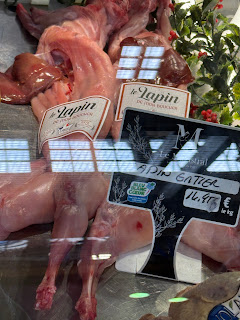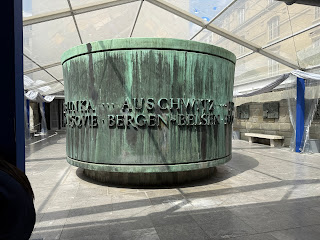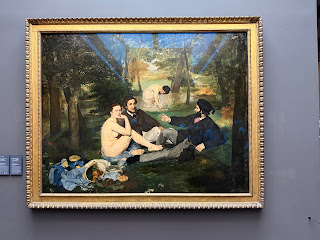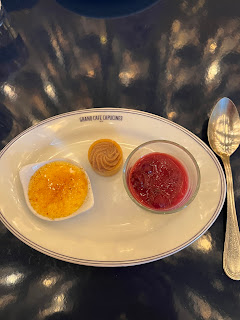Tues
First, a word on Paris fashion. Interestingly, New York Yankees caps seem to be trendy among Parisians. At first I thought I was just seeing a bunch of dumb Americans wearing markers that they were tourists, but then I noticed that I was seeing the hats everywhere, not just around tourist sites. I didn't see any from any other U.S. baseball teams, just the Yankees.
Overall, I'd say American and European fashion has converged over the decades. For example, I remember in the old days being advised not to wear jeans in Europe, since that would peg you as an American. Today, lots of Parisians wear jeans. And Europeans used to wear very different shoes than Americans, but today, sneakers are everywhere. In general, I'd say Parisians on the street dress a little better than Americans (and both men and women wear a lot more jaunty scarves than you'd see in America), but it's harder than it used to be to tell who the tourists are vs. the locals based on clothing. Oh, and I should mention berets. Apparently the French do wear them, but it's seasonal - berets are primarily worn in winter. Sure enough, every person I saw wearing a beret turned out to be a tourist (two beret-wearing girls speaking to each other in Russian, a group of Americans at our hotel, etc.).
Unlike on the previous days, Tuesday didn’t start with a lecture, and the group wasn’t meeting until 10. This gave me time to get a little exercise in the morning – the Slower Pace just wasn’t getting me the workouts I needed. Our hotel was actually an aggregation of a number of old buildings around a charming courtyard, and I woke up early, threw on a t-shirt and shorts, stretched, then crossed the courtyard to the building where the hotel’s gym was located with the idea of a treadmill run; however, it turned out that the hotel gym was a just little room with four weight machines and exactly zero cardio equipment. With early morning temps in the 40’s, it was too cold for me to go running in a t-shirt and shorts, so I went back to our room and bundled up to go for a walk instead (for whatever reason I don’t like going out running in a strange city unless I’ve scoped out a route first). About five minutes into my walk I stumbled on Boulevard Richard Lenoir, which was chock-a-block with runners. I was dressed a little warmly for running, but said “what the heck” and set off jogging down the boulevard. I take it easy when running away from home, out of a fear of suffering a heart attack or other injury in an unfamiliar place, so I did a moderate half hour jog. The boulevard offered long, uninterrupted blocks, a little bit of urban parkland in the middle, which was replaced by canal-ish water down at the far end, and just a chance to explore a residential neighborhood of Paris – including jogging my way through folks setting up an outdoor vegetable market along the boulevard.
Upon my return I showered, then Valerie and I went to breakfast. I'll say it again: the breakfast was good and honestly was frequently our best meal of the day – which is a shame considering we were in one of the world's great food cities.
Speaking of outdoor markets, our first stop of the day was a combination indoor/outdoor vegetable and flea market. Interestingly, in the U.S. farmers' markets are all about buying locally grown produce, whereas in Paris, the vegetable markets bring in produce from all over the country, and each seller marks their various items with their place of origin – so if you’re looking for asparagus from the Loire Valley, or you really love strawberries from Dordogne you can seek out the exact produce you want. It's analogous to appreciating wines by region - I guess even strawberries have terroir. I will also mention that the market had items you’d likely not find in an American market, such as rabbit and octopus.
 |
| Outdoor food market |
 |
| The indoor part of the market |
 |
| Rabbit season |
 |
| Octopus season |
 |
Beans and such
|
 |
| Flowers |
We sampled artisanal bread from a local bakery, including bread made from historic wheat varieties of France, as well as the more common wheat, which apparently Monsanto foisted on France after WW II, just as they’ve strong-armed U.S. farmers into using exclusively their seed varieties.
Then we went for a small lunch, described in the itinerary both as an “aperitif” and as a "picnic". None of the Americans had any idea what this meant, but apparently in France an aperitif meal refers to a meal of small, shared platters, eaten primarily as finger food. Our aperitif included meats, cheeses, breads, hummus, eggplant spread, olives. France has many centuries of well-understood traditions, including these different meal notions. Also, apparently if food is served on a planche (board) it’s meant as shared food and is eaten with your fingers. If it’s on a plate, it’s not.
 |
| Part of our aperitif lunch |
After lunch we had a little bit of free time. Valerie and I checked out the flea market (mostly worthless old schlock), then strolled the neighborhood, where we bought chocolate and soap.
The group next went on a walking tour of the Marais. I had seen in advance that the Marais was the traditional Jewish neighborhood of Paris and was bracing myself to hear yet another sad Medieval Jewish ghetto story – persecution, torture, forced conversion, expulsion. But this was a different and more modern kind of Jewish neighborhood, more akin to the Lower East Side of New York, a place where Eastern European Jews settled when they fled the 19th century pogroms of Eastern Europe. As with many formerly slummy immigrant neighborhoods in big cities (e.g., Williamsburg in Brooklyn), the Marais has gentrified to the hilt, but the core section has retained a certain amount of Jewish flavor. There are places where you can get a pastrami sandwich (pastrami du boeuf!), challah, and falafel. There’s a Judaica store, and a couple of young Hasids offered passing Jews the opportunity to perform the mitzvah of laying teffilin!
We walked past the Paris Shoah (Holocaust) Museum and learned about Resistance members who had at the end of the war dashed around Paris collecting and preserving Nazi/Vichy government records before they were destroyed, providing key evidence which was later used at the Nuremberg trials.
 |
| Shoah Museum |
At the end of the tour Valerie and I broke off from the group and went to the Paris Jewish Museum, which is quite a nice collection, including Jewish ritual and lifestyle items from Europe and North Africa dating back centuries. since we were still in the Marais we had dinner on our own at a famous falafel place where I had a pretty darn good falafel sandwich, topped with various roasted vegetables and pickles, accompanied by a Maccabee (Israeli beer brand). Valerie just had fries and a soda. The place often has a line out front – apparently thanks in part to a recommendation in Rick Steve’s guidebooks – but we went at American dinner time and so got in without a wait ahead of the French dinner crowd. Again, it's sad that one of the best meals of the trip was at a cheap falafel shop. After dinner we strolled back across the Marais to our hotel, checking out all the shops along the way. At a Judaica shop in the Marais Valerie bought a lovely Marrano glass hamsa necklace.
 |
| Jewish food shop in the Marais. |
 |
| Kosher certification in a restaurant window |
 |
| Schwartz's Deli! |
 |
| Falafel dinner |
 |
| Seen at the restaurant |
 |
| Judaica items at the museum |
Wednesday morning we went to the to Place des Victoires. The guides surprised us with excellent croissants from a former Best Croissant 2nd place winner (yes, this is a real thing in Paris; there's a baguette competition too). The sights we visited were a little off the beaten path. We first explored the covered passages – sort of a distant ancestor of the shopping mall. After the revolution, urban real estate occupied by palaces was repurposed into commercial space, resulting in everything from luxury villas converted to factories, complete with with chimneys sticking out of them, to enclosed shopping areas, such as the covered passages we saw today. They’re still actively used shopping areas – sort of like the Crystal City Underground, but of course grander and centuries old. It wasn't a shopping stop, but somehow Valerie managed to sneak off and buy a stuffed animal.
 |
| Palace Royale gardens |
We then walked through the Palace Royale garden. This large space looks like something out of a PBS period drama, or perhaps Bridgerton. Over time it’s been a private garden owned by nobility, as well as a home to prostitution and gambling dens during the Belle Époque. We stopped at the Basilica of Notre-Dame des Victories, a beautiful church built starting in 1629. While Notre Dame cathedral is much grander in scale, I’d say that this church was actually more striking.
 |
| I love how these churches have "Jehovah" written in Hebrew characters |
 |
| Basilica of Notre-Dame des Victoires |
 |
Interiors: Basilica of Notre-Dame des Victoires
|
 |
| The organ is always interesting to me |
 |
| Our newest "family member", named Agatha (after our tour guide) |
From there it was on to The Louvre. We had a chance to check out the pyramid (added in the 1980's), then we were on our own for lunch. I ran and got a sandwich at a local deli; Valerie just ate snacks from her backpack. The deli was a little hard to navigate. There was no menu; rather, I just quickly (it was busy!) scanned the display case to find something I could eat, then ordered it at the counter. The challenge came in picking up my order. They didn't give you a number or anything. Rather, they just called out the sandwich when it was ready. The problem is that if you don't speak French, it's hard to understand what they're calling out, particularly against the din of the crowded room. But I made it work. Valerie and I ate our respective lunches while sitting by the pyramid, then had a few minutes to explore the edge of the Tuilleries gardens before heading to the arranged meeting point.
 |
| Gathering with the group |
 |
| Outside The Louvre |
 |
| Outside The Louvre by the Tuilleries |
 |
Outside The Louvre by the Tuilleries
|
 |
By the Arc de Triomphe du Carrousel |
The Louvre is CROWDED. We were there just long enough to do something of a highlights tour: the Mona Lisa, Venus de Milo, Winged Victory, Da Vinci's La Belle Ferronnière (not even on the tour, but I spotted it), The Raft of the Medusa, Napoleon's Coronation, and a few others. We certainly didn't walk anything near the museum's nine miles of corridors. I imagine that away from the most popular masterpieces there are some quieter parts of the museum, but I really wouldn't have wanted to have spent much more time than I did in the rush hour-like crowds around the popular parts of the museum. After our visit it was, as usual, back onto the bus to be whisked away.
 |
| Venus de Milo |
 |
| Winged Victory |
 |
| La Belle Ferronnière |
 |
| Two great smiles |
 |
Architectural Detail - The former mother-in-law suite
The Louvre |
Honestly, The Louvre would have been worth a visit even without the art. Originally built as a fortress in the 12th century, it was expanded over the centuries into a spectacular and enormous palace, including renovations done by Louis XIV, who didn't actually live there (he built Versailles as his palace), but still used it. The photo above is from a part of the museum which had at one time been an apartment for his mother-in-law. For a while my mother-in-law lived with me too, but the quarters I offered her were significantly less opulent. Maybe Louis was more fond of his mother-in-law than I was of mine 😮. Or maybe he was happy to give his MIL luxurious living quarters in Paris to keep her from getting the idea of coming to stay with him at Versailles.
Dinner that evening included a starter of gazpacho soup followed by a main course of croque monsieur. Now, the croque is something of a high-falutin' grilled cheese with ham, so needless to say I couldn't eat it. I would have accepted a ham-free version (there's already something called a "croque madame", maybe what I was looking for was a "croque they/them"?), but instead they offered a vegetarian platter of vegetables on quinoa (quinoa seems to be very popular as the vegetarian option).
I tasted a bite of Valerie's croque (I picked out the ham). It's a very rich dish and I probably couldn't have eaten more than 1/4 of a vegetarian croque if they had served me one. Needless to say, Valerie didn't like it either. Dessert was flan, another of Valerie's "do not like" foods.
Thurs
I started the day with another early morning jog, then after breakfast we were herded to the Marmottan-Monet Museum, home to the world's largest collection of Monet paintings. Apparently Monet offered his collection of his work to the Louvre, but the stuck-up powers-that-be there rejected it, so it went to this private collection instead. It's a lovely, small museum, and happily lacks the crowds of the Louvre. It was interesting to see how his painting changed over time, and with health considerations such as cataract surgery!
We also saw an exhibit of the art of Eugune Boudin, who discovered Monet working as an illustrator, taught him to paint, and served as his mentor. Boudin was not an Impressionist and in fact was critical of the style, but his paintings hint at the Impressionist ideas – his skies and water have the feel of Impressionism, though his figures are sharply, realistically rendered in a more classical manner. The museum also had an exhibit works by Berthe Morisot, the first female Impressionist painter to exhibit at the Salon de Paris – she inspired the better-known Marie Cassatt. In the tangled world of 19th century art, Morisot was also Manet’s sister-in-law.
 |
| Monet's "Impression, Sunrise", from which Impressionism takes its name |
 |
Another Monet masterpiece
|
 |
| Boudin, a forerunner of Impressionism |
From there we went to the Pigalle district (home to the Moulin Rouge, as well as an enormous number of sex shops – it’s that kind of neighborhood), where we caught a tram up into Montmarte. Yes, at this point we had done a bus tour, a boat tour, and a tram tour. I might as well have “Tourist!” stamped on my forehead (or anywhere on my head – my head has a lot of stampable area). We spent a few hours up in Montmartre, including seeing artists at work in the square, and had lunch at La Bonnie Franquette. This restaurant, housed in a 16th-century building, occupies the space formerly known as “Aux Billards en Bois”, a hangout of Cezanne, Renoir, Gaugin, Van Gogh, Toulouse-Laurence, and more. Valerie had the house special (braised beef and carrots); I had the by-now familiar white fish with creamy sauce. Of course there was wine and a rich dessert (chocolate cake). There was a piano there that I was just aching to play, and I even tried to drop a hint to our tour guide (who is an amateur actress) that we should perform a number together, alas to no avail.
After lunch Valerie went into a savionnaire (soap store), leaving me plenty of time to go get a coffee (perhaps the worst Americano ever) at the local Starbucks while she bought all the soap. Yes, I know, I know, but Starbucks seems to be the only place in Paris with decaf. I also paused to watch two busking accordionists. One was really, really good, while the other seemed to only play La Vie en Rose again and again.
 |
| Montmartre street scene |
 |
| Valerie evaluating soap |
 |
| Another accordionist |
I should mention the origin of the name Montmartre, which derives from the French for "Mountain of the Martyr". According to legend, Denis, an early Bishop of Paris, was tortured (grilled in a furnace, given to hungry lions, and hung from a cross) and beheaded at Montmartre by the Romans for the crime of converting too many people to Christianity. After his head was cut off, Denis is said to have picked it up, washed it off in a stream, and walked five miles from the summit of the hill, preaching a sermon the entire way, before finally coming to rest at his chosen burial place. Thus, in art he is usually depicted holding his decapitated head. Apparently, while the walking, preaching headless thing is unusual, there are enough Christian martyrs depicted headless that there's a name for them: cephalophores.
Dinner was on our own. Rather than go out for a big meal, we ate at a little Italian café (apparently in Paris there’s a definitional difference among restaurants, cafés, bistros, brasseries, and boulangeries – a café means a smaller, faster meal). Upon our return to the hotel Valerie went up to our room to watch the news about a new pope having been selected while I went out to find a geocache (success!) so I could add France to the list of countries where I’ve found caches. While I was on my way out I bumped into a couple from our trip who were extremely excited that they had learned about the pope while they were at mass at Notre Dame Cathedral. They have gone to mass there a couple of times during the trip (I guess they’re devout Catholics) and they were really, really jazzed.



































































